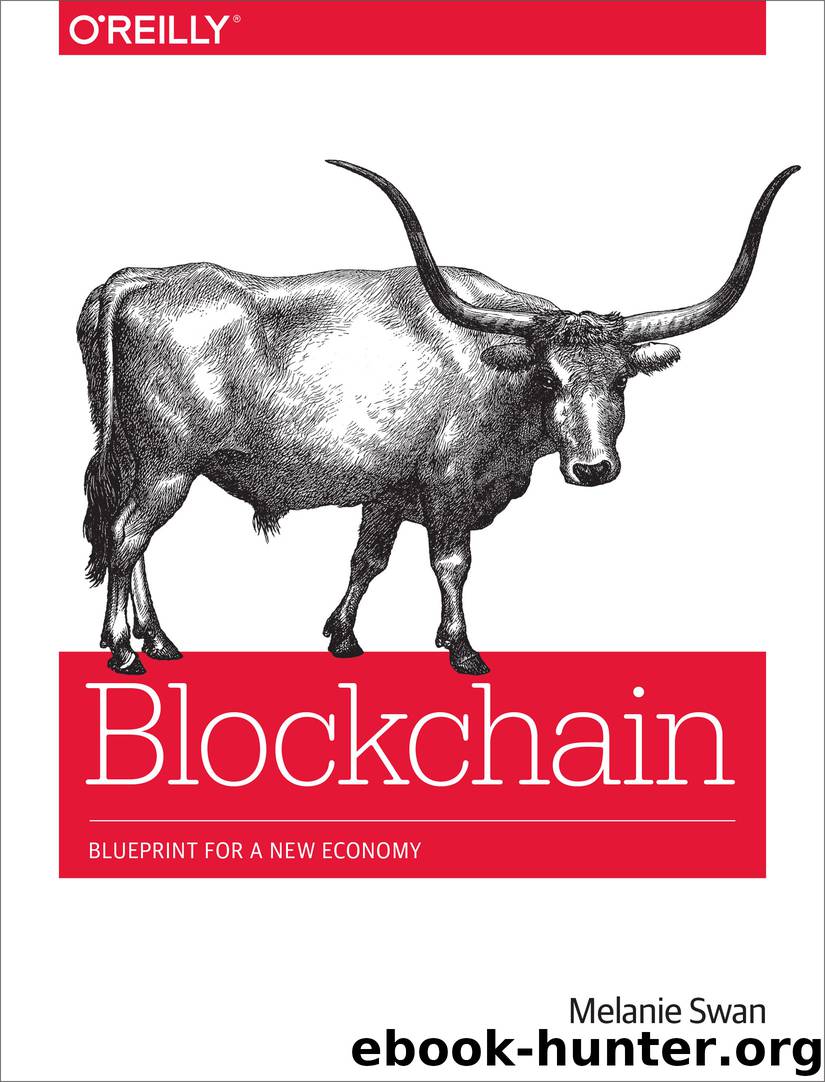Blockchain: Blueprint for a New Economy by Swan Melanie

Author:Swan, Melanie [Swan, Melanie]
Language: eng
Format: epub
ISBN: 9781491920497
Amazon: 1491920491
Publisher: O'Reilly Media
Published: 2015-02-08T07:00:00+00:00
Blockchain Genomics 2.0: Industrialized All-Human-Scale Sequencing Solution
At one level, there could be blockchain-enabled services where genomic data is sequenced and made available to individuals by private key outside the jurisdiction of local governments. However, at another higher level, as a practical matter, to achieve the high-throughput sequencing needed for all seven billion humans, larger-scale models are required, and blockchain technology could be a helpful mechanism for the realization of this project. Individuals ordering their genomes piecemeal through consumer genomic services is an initial proof of concept in some ways (and a health literacy tool as well as a possible delivery mechanism for personal results and recommendations), but not an “all-human-scale” solution for sequencing. Blockchain technology, in the form of a universal model for record keeping and data storage and access (a secure, decentralized, pseudonymous file structure for data stored and accessed in the cloud) could be the technology that is needed to move into the next phase of industrialized genomic sequencing. This applies to genomic sequencing generally as an endeavor, irrespective of the personal data rights access issue. Sequencing all humans is just one dimension of sequencing demand; there is also the sequencing of all plants, animals, crops, viruses, bacteria, disease-strain pathogens, microbiomes, cancer genomes, proteomes, and so on, to name a few use cases.
There is a scale production and efficiency argument for blockchain-based transnational genomic services. To move to large-scale sequencing as a “universal human society,” the scope and scale of sequencing and corresponding information processing workloads suggests not just transnationality, but more important, heavy integration with the cloud (genomic data is too big for current forms of local storage and manipulation), and the blockchain delivers both transnationality and the cloud. Transnational regional centers for genomic sequencing and processing and information management of the sequenced files could be the best way to structure the industry given the cost, expertise, equipment, and scale required. This could be a more efficient solution rather than each country developing its own capabilities. Blockchain technology might be used to achieve a high-throughput level of industrialized genomic sequencing—on the order of millions and billions of genomes, well beyond today’s hundreds. In reality, blockchain technology might supply just one aspect of what might be needed; other issues are more critical in achieving industrialized genomic sequencing operations (information processing and data storage is seen as the real bottleneck). However, the blockchain ecosystem is inventing many new methods for other operational areas along the way and might be able to innovate in a complementary manner for a full solution to industrial-scale genomic sequencing, including recasting the problem in different ways as with decentralization concepts.
Download
This site does not store any files on its server. We only index and link to content provided by other sites. Please contact the content providers to delete copyright contents if any and email us, we'll remove relevant links or contents immediately.
| Cryptography | Encryption |
| Hacking | Network Security |
| Privacy & Online Safety | Security Certifications |
| Viruses |
Effective Threat Investigation for SOC Analysts by Yahia Mostafa;(7371)
Practical Memory Forensics by Svetlana Ostrovskaya & Oleg Skulkin(7090)
Machine Learning Security Principles by John Paul Mueller(7057)
Attacking and Exploiting Modern Web Applications by Simone Onofri & Donato Onofri(6718)
Operationalizing Threat Intelligence by Kyle Wilhoit & Joseph Opacki(6701)
Solidity Programming Essentials by Ritesh Modi(4516)
Microsoft 365 Security, Compliance, and Identity Administration by Peter Rising(4100)
Operationalizing Threat Intelligence by Joseph Opacki Kyle Wilhoit(3853)
Learn Computer Forensics - Second Edition by William Oettinger(3594)
Building a Next-Gen SOC with IBM QRadar: Accelerate your security operations and detect cyber threats effectively by Ashish M Kothekar(3563)
Future Crimes by Marc Goodman(3517)
Blockchain Basics by Daniel Drescher(3493)
Mastering Azure Security by Mustafa Toroman and Tom Janetscheck(3470)
Mastering Python for Networking and Security by José Manuel Ortega(3448)
Incident Response with Threat Intelligence by Roberto Martínez(3330)
The Code Book by Simon Singh(3069)
Mastering Bitcoin: Programming the Open Blockchain by Andreas M. Antonopoulos(2979)
Mobile App Reverse Engineering by Abhinav Mishra(2956)
From CIA to APT: An Introduction to Cyber Security by Edward G. Amoroso & Matthew E. Amoroso(2856)
